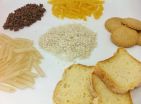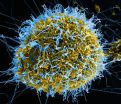(Press-News.org) Respiratory Syncytial Virus causes severe respiratory tract infections and worldwide claims the lives of 160,000 children each year. Scientists at VIB and Ghent University have succeeded in developing a promising vaccination strategy to counteract this common virus infection.
Xavier Saelens (VIB/UGent): "We discovered a new vaccination strategy that paves the way for the development of a novel approach to vaccination against RSV, a virus that causes suffering in numerous small children and elderly people."
RSV: an infection that is difficult to combat
The Respiratory Syncytial Virus - abbreviated to RSV - is the most important cause globally of viral respiratory tract infections in young children. Children with a high risk of complications caused by RSV are sometimes treated preventively to avoid the infection, but this treatment is expensive and does not work therapeutically. Children with RSV infections are often hospitalized and primarily receive supportive care. There is no medicine available yet that can effectively suppress an RSV infection. RSV infections are also common in the elderly and they can become severely ill as a result.
Searching for a RSV vaccine: prevention is better than cure
Previous attempts to develop a vaccine against RSV have failed miserably. A vaccine must prime our immune system so that it can protect us against a pathogen. The starting point in the development of a vaccine is usually the proteins that are present on the outside of the virus. Many scientists and pharmaceutical companies are targeting the two large envelope proteins - F and G - in the development of a RSV vaccine, but these approaches are have yet to prove clinical benefit against disease caused by RSV.
Bert Schepens, Xavier Saelens and Walter Fiers (VIB/UGent) searched for an alternative strategy to attack the virus. They focused on a small, seemingly insignificant envelope protein of RSV, the so-called Small Hydrophobic protein (SHe). The immune system barely notices this viral protein during an infection with RSV. Therefore, the scientists linked the extracellular part of SH to another molecule. The resulting SHe conjugate did induce antibody production in laboratory animals.
New vaccine offers protection in lab animals
The SHe-specific antibodies do not neutralize RS virus in vitro. However, mice that were vaccinated with the SHe vaccine were protected against a challenge with the virus. The growth of RSV in the lung tissue of the vaccinated animals was significantly reduced and the animals did not become ill. The experiments were repeated in cotton rats as these animals are naturally more sensitive to RSV infections. The positive results were confirmed: pretreatment with the SHe-vaccine suppressed the replication of RSV in the lung tissue of the infected cotton rats.
Surprising mechanism of action
As no neutralizing antibodies were induced, the vaccine must offer protection via a different mechanism. The scientists also unraveled this mechanism. The SHe-specific antibodies stimulate macrophages (cells that absorb foreign particles) in the respiratory tract to such an extent that they selectively ingest (phagocytose) the virus-infected cells
Bert Schepens (VIB/UGent): "This alternative approach to battle RSV has never been studied before and this is exactly the pathway that is triggered by the new candidate vaccine. The SHe-based vaccine could be linked to other candidate vaccines directed against the larger envelope proteins of the virus, to double hit the virus: with neutralizing antibodies in addition to antibodies that stimulate macrophages to selectively eliminate infected cells".
INFORMATION:
Questions
As this research may raise questions, we want to ask you to list the e-mail address that the VIB has made available for questions in your report or article. Everyone can contact us with questions about this research and other medical research: patients@vib.be.
Research
Protection and mechanism of action of a novel human Respiratory Syncytial Virus vaccine candidate based on the extracellular domain of Small Hydrophobic protein. Bert Schepens, Koen Sedeyn, Liesbeth Vande Ginste, Sarah De Baets, Michael Schotsaert, Kenny Roose, Lieselot Houspie, Marc Van Ranst, Brian Gilbert, Nico van Rooijen, Walter Fiers, Pedro Piedra, Xavier Saelens. EMBO Molecular Medicine
Note to the editor
Credits
When reporting on this research, please mention all partners involved.
VIB
VIB is a non-profit research institute in life sciences. About 1,300 scientists conduct strategic basic research on the molecular mechanisms that are responsible for the functioning of the human body, plants, and microorganisms. Through a close partnership with four Flemish universities − UGent, KU Leuven, University of Antwerp, and Vrije Universiteit Brussel − and a solid funding program, VIB unites the forces of 83 research groups in a single institute. The goal of the research is to extend the boundaries of our knowledge of life. Through its technology transfer activities, VIB translates research results into products for the benefit of consumers and patients and contributes to new economic activity. VIB develops and disseminates a wide range of scientifically substantiated information about all aspects of biotechnology. More information: http://www.vib.be.
Ghent University
After more than twenty years of uninterrupted growth, Ghent University is now one of the most important institutions of higher education and research in the Low Countries. Ghent University yearly attracts over 35,000 students, with a foreign student population of over 2,200 EU and non-EU citizens. Ghent University offers a broad range of study programs in all academic and scientific fields. With a view to cooperation in research and community service, numerous research groups, centers and institutes have been founded over the years. For more information http://www.UGent.be.
New perspectives for development of an RSV vaccine
2014-10-16
ELSE PRESS RELEASES FROM THIS DATE:
Mild traumatic brain injury can have lasting effects for families, reports the American Journal of Nursing
2014-10-16
October 16, 2014 – Families of patients with mild traumatic brain injury (TBI) may expect them to return to normal quickly—after all, it's "just a concussion." But mild TBI can have a lasting impact on families as well as patients, according to a review in the November issue of American Journal of Nursing. The journal is published by Lippincott Williams & Wilkins, a part of Wolters Kluwer Health.
"With the increasing numbers of people with mild TBI in the community, it's crucial for nurses to make this a part of assessment for early recognition and intervention," ...
Energy prices and business decision-making in Canada: Preparing for the energy future
2014-10-16
A new expert panel report, Energy Prices and Business Decision-Making in Canada: Preparing for the Energy Future, released today by the Council of Canadian Academies, details how Canadian businesses have historically been successful in responding to fluctuating energy prices, but this should not be considered a predictor for future resiliency or competiveness. The energy environment is evolving with advances in oil and gas extraction, the development of alternative energy sources, changes within the electricity market, and new regulatory requirements. Understanding the ...
The social web of things
2014-10-16
Research to be published in the International Journal of Web-Based Communities suggests that the familiar interfaces of online social networking sites might be adapted to allow us to interact more efficiently with our networked devices such as cars, domestic appliances and gadgets. The concept would also extend to the idea of those devices connecting with each other as necessary to improve efficiency of heating and lighting, make our home entertainment systems smarter and much more.
Are you Facebook friends with your microwave oven, is your car? Does your washing machine ...
Informative visit to the toilet
2014-10-16
Emily loves Justin - Stop global warming - Two more weeks till I graduate!: The exchange of information in public toilets is widespread. It also occurs in the world of white-footed sportive lemurs. Only instead of writing on the walls, they use scent-marks in order to communicate with their own kind. In a study published online in Springer's journal Behavioral Ecology and Sociobiology, Iris Dröscher and Peter Kappeler from the German Primate Center (DPZ) have found that the urine left on latrine trees serves as a method to maintain contact with family members. It also ...
Adenosine can melt 'love handles'
2014-10-16
The number of overweight persons is greatly increasing worldwide - and as a result is the risk of suffering a heart attack, stroke, diabetes or Alzheimer's disease. For this reason, many people dream of an efficient method for losing weight. An international team of researchers led by Professor Alexander Pfeifer from the University Hospital Bonn, have now come one step closer to this goal. The scientists discovered a new way to stimulate brown fat and thus burn energy from food: The body's own adenosine activates brown fat and "browns" white fat. The results are now being ...
Some rice-based foods for people with celiac disease contain relevant amounts of arsenic
2014-10-16
Rice is one of the few cereal grains consumed by people with celiac disease, as it does not contain gluten. However, it can have high concentrations of a toxic substance – arsenic – as revealed by the analyses of flour, cakes, bread, pasta and other foods made with rice, conducted by researchers from the Miguel Hernández University of Elche, Spain. The European Union is working to establish the maximum quantities of arsenic in these products.
Celiac disease affects almost 1% of the population of the western world, a group which cannot tolerate gluten ...
Pre-eclampsia may be caused by the fetus, not the placenta, says Anaesthesia editorial
2014-10-16
Pre-eclampsia, the potentially deadly condition that affects pregnant women, may be caused by problems meeting the oxygen demands of the growing fetus, according to an editorial in the November issue of Anaesthesia, the journal of the Association of Anaesthetists of Great Britain and Ireland (AAGBI).
The finding has promoted the co-author of the editorial, Associate Professor Alicia Dennis, Consultant Anaesthetist & Director of Anaesthesia Research at the Royal Women's Hospital in Melbourne, Australia, to call for the name of the condition to be changed to make women ...
Youth suicide: More early detection and better coordination are needed
2014-10-16
This news release is available in French. Although progress has been made in recent years, the matter of youth suicide in Quebec still needs to be more effectively addressed. In fact, a new study in the Canadian Journal of Psychiatry shows that more lives could be saved through early detection and increased public awareness and information sharing among professionals.
For this research, a team of scientists from the Douglas Mental Health University Institute and McGill University studied 67 suicide completers ages 25 and under and matched them with 56 living control ...
Ebola highlights disparity of disease burden in developed vs. developing countries
2014-10-16
A study recently published in the Journal of the American Academy of Dermatology shows that for Ebola, measles, syphilis and many other conditions with skin manifestations the mortality rates are hundreds of times higher in developing countries than they are in developed countries. The case of Ebola, the paper writes, "Highlights the importance of monitoring disease burden in the developing world even when the burden is low."
"Our goal is to provide information about trends and patterns to bring to light what's going on around the world so that funds can be allocated ...
Rivers flow differently over gravel beds, study finds
2014-10-16
CHAMPAIGN, Ill. — River beds, where flowing water meets silt, sand and gravel, are critical ecological zones. Yet how water flows in a river with a gravel bed is very different from the traditional model of a sandy river bed, according to a new study that compares their fluid dynamics.
The findings establish new parameters for river modeling that better represent reality, with implications for field researchers and water resource managers.
"The shallow zones where water in rivers interacts with the subsurface are critical environmentally, and how we have modeled ...





